The U.S. Securities and Exchange Commission (the “Commission” or the “SEC”) is the most important regulator of U.S. capital markets. Its budget has increased by 82 percent over 10 years. But these resources have flowed into unnecessary management, “support,” and ancillary functions, while core functions have been neglected. Its organizational structure is unwieldy. It is management-heavy and highly bureaucratized. The number of direct reports to the Chairman needs to be reduced. Its information technology (IT) programs appear to be poorly managed and are unnecessarily costly. Its contracting deserves much tighter scrutiny. The Commission needs to be better managed, and it needs to become a better steward of taxpayer dollars.
The SEC bases its decisions on inadequate data and does much less than most agencies to provide data to Commissioners, other policymakers, and the public. Its enforcement efforts directed at fraud and other malfeasance by managers of large financial institutions are inadequate. The Commission does little to remove unnecessary regulatory impediments to entrepreneurial capital formation. This Backgrounder recommends a series of reforms so that the SEC can better support well-functioning capital markets.
The Function of the SEC
The mission of the SEC is to “protect investors, maintain fair, orderly, and efficient markets, and facilitate capital formation.”REF The Commission investigates violations of securities laws and enforces those laws.REF It regulates how securities are issued and traded. Its rules regulate the content and timing of financial and other disclosures that companies, their executives, and certain owners must make. It regulates investment companies, stock exchanges, variable life insurance products, federally registered investment advisers, broker–dealers, transfer agents, clearing agencies, credit-rating agencies, and “self-regulatory organizations” such as the Financial Industry Regulatory Authority (FINRA).REF It imposes fines for non-compliance. In some circumstances, when the SEC recovers money on behalf of wronged investors, it distributes that money to investors. In cases of possible criminal violations, it refers matters to the Justice Department.
The Organization of the SEC
The SEC has five divisions: (1) Corporation Finance,REF (2) Investment Management,REF (3) Enforcement,REF (4) Trading and Markets,REF and (5) Economic and Risk Analysis.REF
- The Division of Corporation Finance regulates the disclosure of information by companies to investors.
- The Division of Investment Management regulates investment companies (such as mutual funds or exchange-traded funds), variable life insurance products, and investment advisers.
- The Division of Enforcement investigates possible violations of federal securities laws, recommends to the Commission that it initiate civil or administrative proceedings against violators, and makes criminal referrals to the Justice Department.
- The Division of Trading and Markets regulates broker–dealers, stock and option exchanges, clearing agencies, and self-regulatory organizations such as FINRA.
- The Division of Economic and Risk Analysis provides economic and data analysis as part of the rule-making and enforcement functions of the SEC.
The Commission has 11 regional offices.REF There are 24 other offices within the SEC.REF The Office of Administrative Law JudgesREF and the Office of Compliance Inspections and ExaminationsREF are particularly noteworthy. In addition, the Office of the Advocate for Small Business Capital Formation was created by the SEC Small Business Advocate Act of 2016.REF The appointment of a small business advocate by the Commission was announced on December 21, 2018.REF
The SEC Budget
The SEC budgets and full-time equivalent (FTE) employee counts for the past 15 years are shown in Table 1.
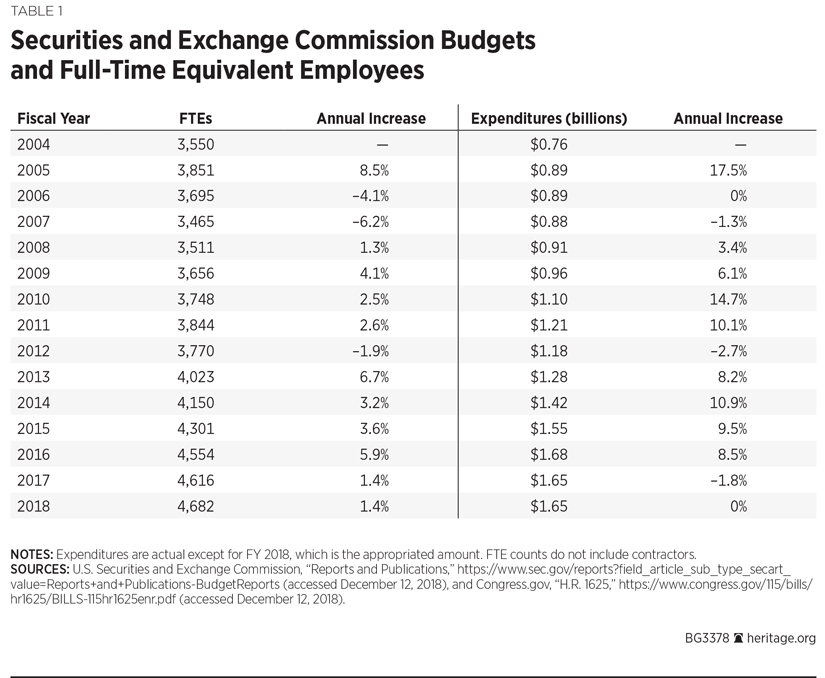
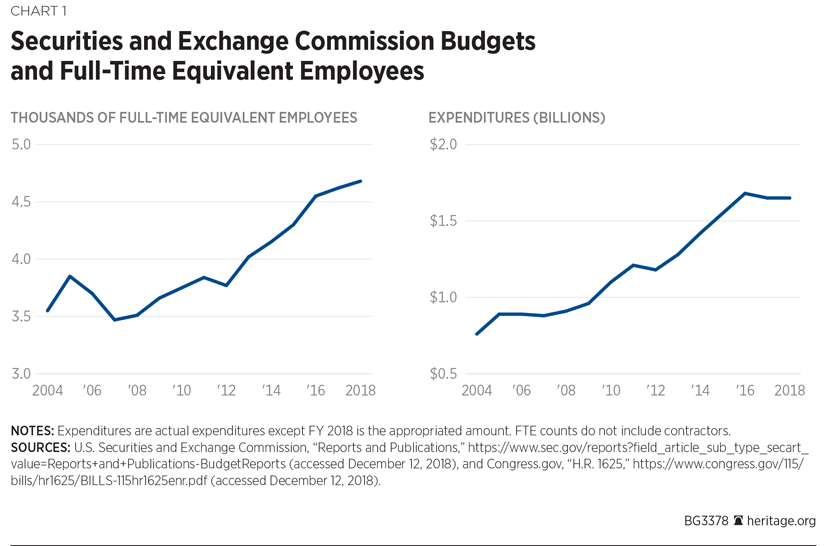
In Table 2, the SEC budget and personnel growth are compared to overall federal spending, non-entitlement domestic spending, inflation, and the size of the economy (as measured by gross domestic product).
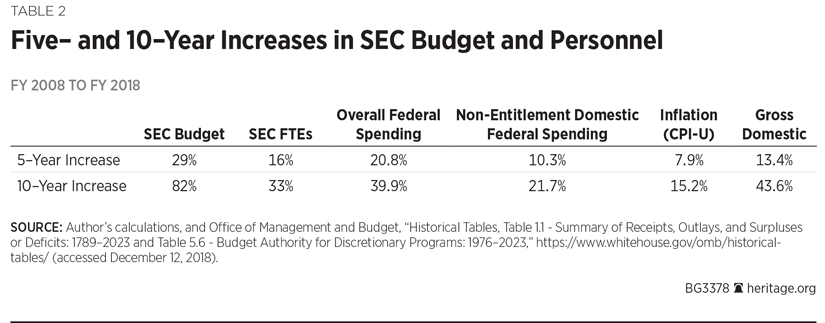
This is not, as some have argued, the story of a resource-deprived agency.REF The Commission’s personnel count has increased by nearly one-third, and its budget has grown 82 percent over the past 10 years. Its budget has grown more rapidly than overall federal spending, non-entitlement domestic spending, inflation, and the economy. Over the past decade, the SEC’s budget has increased at about twice the rate that the overall federal budget or that the economy has increased. It has increased more than five times the rate of inflation. Thus, by almost any relevant measure, the SEC’s resources have grown dramatically.
Rather than increase the SEC budget, the agency should be required to spend its resources more effectively. There are a number of areas that deserve special scrutiny.
Contract Oversight and Spending
The SEC spent $377,529,843 in FY 2017 on contracts.REF This amounted to 23 percent of its FY 2017 spending and nearly $82,000 per employee. The overwhelming majority of these contracts fell into two categories: information technology and telecommunications ($186 million or 49.2 percent of obligated amounts) and “support” ($138 million or 36.5 percent of obligated amounts). Combined, these two categories amounted to 85.7 percent of all SEC contractually obligated amounts.
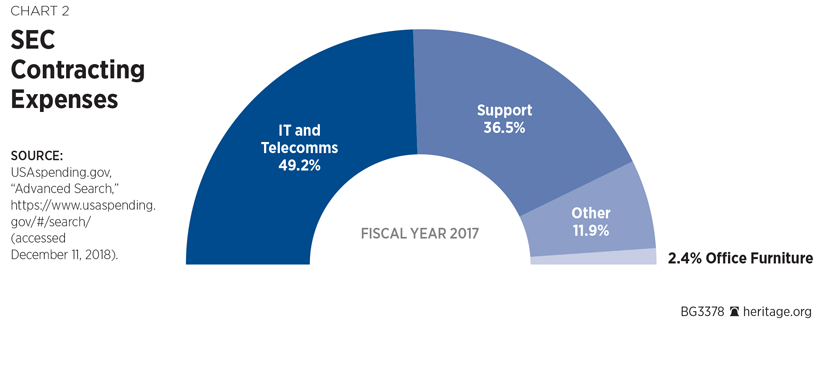
Information technology (IT) and telecommunications includes hardware ($32 million), software ($68 million), information technology strategy and architecture ($27 million), systems development ($20 million), programming ($2 million), and the like. Support includes contract workers doing administrative, accounting, management, public relations, and other work, expert witnesses ($25 million), legal counsel ($45 million), and “program management” ($24 million). These expenditures call for greater scrutiny.
The SEC also spent $9,140,914 on office furniture in FY 2017. With 4,616 full-time equivalent employees that year, that works out to $1,980 per employee in one year. This seems excessive by almost any standard. Although it is not a major expenditure in the greater scheme of things, it does raise questions about the care with which the SEC stewards taxpayer money in areas that are less easy to visualize.REF
Management Heavy and Overly Bureaucratized
Both informal conversations with agency personnel and data support the proposition that the agency has become management heavy and overly bureaucratized. The SEC Office of Minority and Women Inclusion reports that in FY 2017 the SEC had 902 managers.REF Thus, 20 percent of the 4,616 employees at the SEC in FY 2017 were managers.REF In other words, the ratio of employees to managers is 4 to 1. This is an excessive number of managers. In most organizations, the ratio is between 5 to 1 and 10 to 1.REF As shown in Table 3, in the federal government, the average for all agencies is 7.2 to 1 (80 percent higher than the SEC). In other words, the SEC has 64 percent more managers per employee than does the federal government on average and 53 percent more managers per employee than other large independent agencies.REF
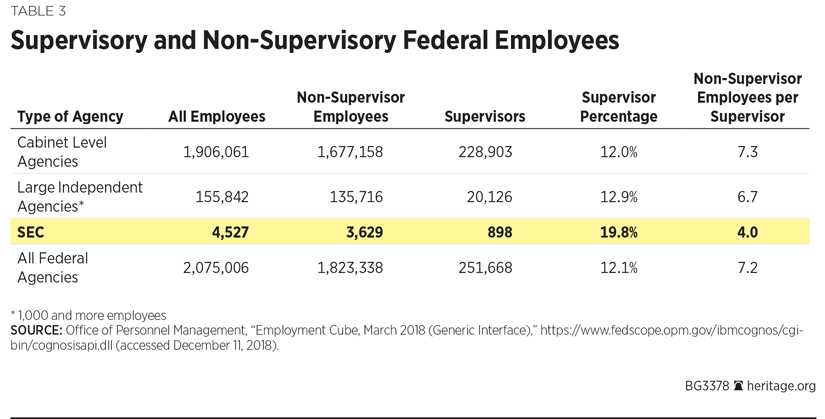
The number of persons whose function is “Agency Direction and Administrative Support” has climbed to 691 in 2018 from 431 in 2008—or by 60 percent. That is nearly twice the rate at which the overall number of agency personnel has increased (from 4,682 to 3,511, or 33 percent). Conversely, key functions such as enforcement have grown much more slowly. Enforcement personnel increased from 1,148 in 2008 to 1,373 in 2018, or by 19.6 percent (roughly one-third of the increase in management and support personnel).
In its FY 2019 budget justification, the agency is seeking to increase its executive staff, its public affairs staff, its administrative staff working for the chief operating officer, and its information technology staff. At the same time, it is proposing reductions in the staff discharging the Commission’s core missions in the Division of Enforcement, Office of Compliance Inspections and Examinations, and the Division of Corporation Finance.
The agency needs to devote fewer resources and personnel to administration and multiple layers of management and more resources to discharging its core functions. In other words, it needs to be managed better. It does not need more managers or executive staff (as has been proposed in its FY 2019 budget justification). Although such an initiative would not grab headlines, it would increase the Commission’s effectiveness without demanding more resources from taxpayers.
Merge Offices with Overlapping Functions
Having two offices discharging similar functions undoubtedly creates inefficiencies. First, the Office of Equal Employment Opportunity and the Office of Minority and Women Inclusion should be merged.REF Their functions overlap. The new office should report to the Chief Operating Officer (COO) or the Director of the Office of Human Resources, who in turn reports to the COO. Second, the Office of Investor Education and Advocacy should be merged into the Office of the Investor Advocate Office.REF
Reduce the Number of Direct Reports to the SEC Chairman
Under Reorganization Plan No. 10 of 1950,REF the Chairman has executive authority over the SEC staff and, absent a statutory requirement, the structure of the SEC. Currently, there are 23 managers who report directly to the Chairman (counting the just appointed Advocate for Small Business Capital Formation position created in 2016). This is two to four times the number typically considered optimal (typically 5 to 10)REF and more than the vast majority of government agencies or private enterprises.
The SEC should be restructured to reduce the number of direct reports to the Chairman. Specifically, the following offices should be merged into other offices and their managers made to report to an SEC official other than the Chairman:
- Office of the Secretary;
- Office of the Ethics Counsel;
- Office of International Affairs;
- Office of the Chief Accountant;
- Office of Credit Ratings;
- Office of Municipal Securities;
- Office of Public Affairs;
- Office of Legislative and Intergovernmental Affairs;
- Office of Equal Employment Opportunity;
- Office of Minority and Women Inclusion; and
- Office of Investor Education and Advocacy.
The Office of the Secretary, the Office of the Ethics Counsel, and the Office of International Affairs should be merged into the Office of the General Counsel. Alternatively, all or some functions of the Office of International Affairs could be moved to the Division of Corporate Finance. Legal functions, such as providing ethics advice and enforcement, providing legal advice to the Commission regarding Commission procedures, and administrative law and international comparative law and coordination should be unified under one chief legal officer, the General Counsel.
The Office of the Chief Accountant and the Office of Credit Ratings should be merged into the Division of Corporate Finance. The Office of Municipal Securities should be merged into either the Division of Corporate Finance or the Division of Trading and Markets. The Office of the Chief Accountant should become an office within the Division of Corporate Finance and their functions integrated. The primary duty of Office of the Chief Accountant involves financial accounting disclosures. That, combined with non-financial accounting disclosure, is also the core function of the Division of Corporate Finance. The Office of Credit Ratings also plays a key function in the disclosure process, particularly with respect to debt securities and ensuring the integrity of the rating process by rating organizations. It also should become an office within the Division of Corporate Finance.
The Office of Compliance Inspections and ExaminationsREF has seven offices or programs within itREF and employs about 1,047 people, or 23 percent of the SEC staff.REF It should be made a Division. It is larger than all SEC Divisions except for the Enforcement Division and has comparable scope and responsibility to the Divisions.
The Office of Public Affairs and the Office of Legislative and Intergovernmental Affairs discharge allied functions. They should be integrated into a single office. There is no need to have two separate directors reporting separately to the Chairman. The director of the new office could also report to someone other than the Chairman such as the Chief of Staff.
These changes would reduce the number of direct reports to the Chairman from 23 to 12. Most of these changes can be undertaken by the Chairman because of the authority granted by Reorganization Plan No. 10 of 1950. A few may require statutory changes. The offices still reporting directly to the Chairman would be:
- Division of Corporation Finance;
- Division of Investment Management;
- Division of Enforcement;
- Division of Trading and Markets;
- Division of Economic and Risk Analysis;
- Division of Compliance Inspections and Examinations (not currently a Division);
- Office of the General Counsel;
- Office of the Chief Operating Officer;
- Office of Administrative Law Judges;
- Office of Inspector General;
- Office of the Investor Advocate; and
- Office of the Advocate for Small Business Capital Formation.
The Office of the Investor Advocate and the Office of the Advocate for Small Business Capital Formation are required by law to report to the Chairman.
Information Technology Expenditures Appear to Be Excessive
The Commission had 171 information technology FTEs in FY 2017.REF This was 3.7 percent of its employees.REF The Commission reports its IT payroll as $41 million.REF It spent another $186 million on IT contracts. Its total IT expenditures in FY 2017 were approximately $227 million, or nearly 14 percent of its overall FY 2017 spending. This is five times higher than the government average of 2.8 percent.REF
The Table below shows IT expenditures and overall outlays by agency as reported in the federal budget and illustrates that the SEC’s IT spending is dramatically higher than that of most agencies as a share of overall spending. Thus, there is strong reason to believe that the Commission’s IT budget is not being managed effectively.REF
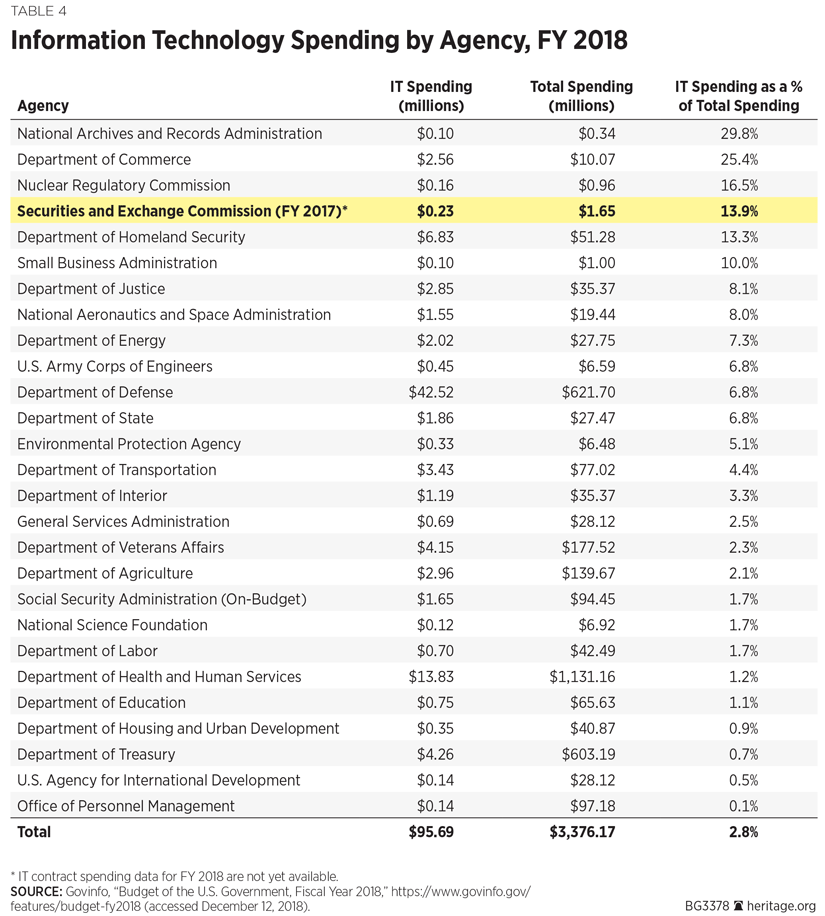
In its FY 2019 budget request, the SEC indicated that it wants to increase the number of IT staff positions to 196, a 12 percent increase over its FY 2017 level of 175.REF This increase is unwarranted until a serious review of SEC IT spending is undertaken.
The Electronic Data Gathering, Analysis, and Retrieval system (EDGAR) which provides disclosure documents to the public was established in 1984.REF There is a serious need to improve EDGAR. Its search functions and user-friendliness have progressed little since the 1990s. Because the system is so inadequate, most investors use private systems that display the information in a more useful and accessible format.REF In addition, the system has proved to be insecure: It was hacked in 2016.REF This is highly problematic since the information in EDGAR documents can move markets considerably, and being able to access that information before it is made public could yield hackers considerable profit were they to trade on that information.
Re-evaluate SEC Inspector General Staffing Levels
The Office of the Inspector General audits and investigates the programs and operations of the SEC.REF Forty-eight people—over 1 percent of SEC personnel—work for the Office of the Inspector General (OIG).REF That is a 340 percent increase over the level in 2008 (11 persons).REF Given the dramatic increase, the budget and staffing levels of the SEC OIG deserves serious scrutiny. It may be that this level of staffing is warranted by the level of malfeasance or other operational difficulties at the Commission. More likely, the staff level, which stood at 18 as recently as FY 2013,REF was ramped up and has not been seriously re-evaluated since by either the Commission or Congress due to bureaucratic and political inertia.
Reforming the Commission
The SEC operates under Reorganization Plan No. 10 of 1950.REF That plan transferred from the Commission (composed of five Commissioners) to the Chairman of the Commission power over “(1) the appointment and supervision of personnel employed under the Commission, (2) the distribution of business among such personnel and among administrative units of the Commission, and (3) the use and expenditure of funds.”REF However, “the appointment by the Chairman of the heads of major administrative units under the Commission shall be subject to the approval of the Commission.”REF
In practice, this means that the Chairman of the Commission has almost unrestricted power over how the Commission is run and its agenda. The four other commissioners have little influence over its agenda or its operation. One of the reasons to have a bipartisan, multi-member commission is to allow various perspectives to have weight in the agency’s operation, deliberations, and agenda. Congress should amend the reorganization plan such that three members would have the ability to place an item on the Commission’s agenda and, if it relates to a rule-making, receive adequate staff support to develop an idea to the point at which the Commission can vote on whether to instruct the staff to develop a proposed rule.
Allowing two members to place an item on the agenda and to receive adequate staff support to do so should be considered. It would lead to a dramatically more robust and open debate at the Commission and force the Commission to address issues that it would not otherwise address. Such a rule would be analogous to the Supreme Court practice of granting a writ of certiorari if four of the nine justices wish to do so. This could have a salutary impact on public policy over the longer term by fostering public debate on important issues. It could, however, result in a diversion of staff resources and Commission time to the concerns of the minority and, therefore, hinder the ability of the majority to further its agenda. It is not clear, however, that the minority would want to bring an issue before the Commission unless there was a realistic chance of the matter achieving majority support.
Enforcement
While it is preferable to achieve compliance without launching an enforcement investigation or action, enforcement of the securities laws is one of the leading responsibilities of the Commission. Yet in FY 2018, only 30 percent (1,373 out of 4,518) of the Commission’s staff is dedicated to enforcement.REF Enforcement personnel increased from 1,148 in 2008 to 1,373 in 2018, or by 19.6 percent. This is roughly one-third, in percentage terms, of the increase in management and support personnel and one-half of the increase in overall agency personnel. In its FY 2019 budget request, the Commission has proposed actually reducing the number of full-time equivalent employees in the Division of Enforcement compared to FY 2018.REF And the number of enforcement FTEs for FY 2018 was lower than in FY 2017.REF The Commission needs to refocus on this core mission. The resources devoted to enforcement should be increased with a focus on employing investigators rather than enforcement managers or attorneys. The resources devoted to administration and management should be reduced.
Many large financial institutions have committed multi-billion-dollar frauds.REF Innocent shareholders of these firms have paid more than $300 billion in settlements and fines.REF Not all of these settlements and fines related to fraud. Some involved other unlawful activity. Yet in the fraud cases, almost none of the culpable individual managers who committed fraud have been barred from the industry, had civil money penalties imposed, or been subject to criminal prosecution.REF
The prevention, deterrence, and punishment of fraud is a central objective of the securities laws—yet the individuals who committed fraud in large institutions have been able to do so largely free of any individual consequences. This policy encourages fraud because those that profit from fraud in large institutions know that they are very unlikely to personally bear any adverse legal consequences. And the policy of imposing corporate fines harms rather than protects shareholders. Both the SEC and FINRA have failed to adequately enforce the fraud laws against the actual persons who committed these multi-billion-dollar frauds.
Enforcement officials, when criticized about the lack of pursuit of individual malefactors, usually cite the difficulty of determining which individuals actually perpetrated the fraud in the context of a large organization. They are also reluctant to devote the time and resources necessary to successfully pursue individual malefactors given the large resources available to defend culpable management of these large firms from individual legal responsibility for fraud. Enforcement officials are usually satisfied with headlines announcing the imposition of large fines on the corporation—even though these fines are borne by innocent shareholders rather than the individuals who committed the fraudulent acts. Enforcement personnel may also be reluctant to pursue individuals from fear of damaging their future employment prospects at large firms or at the large law and accounting firms that perform services for large firms. This will be particularly true of those in top management, who typically have short terms of service before returning to the private sector.
In the interest of justice and investor protection, there is a need to adequately pursue individual managers who commit fraud while employed by large firms. The creation of a Complex Case Unit within the Enforcement Division with the institutional expertise and mission of addressing large corporate fraud is warranted.
Better Data and Better Metrics
The SEC should substantially improve the collection and publication of data with respect to securities markets, securities offerings, securities market participants, and securities law enforcement.
Data available to the Commission and congressional policymakers with respect to securities markets, securities offerings, securities market participants, and securities law enforcement is seriously deficient. This becomes evident when what is available to the Commission and Congress in the securities regulation field is compared to, for example, the Internal Revenue Service Statistics of Income relevant to tax policy,REF the data provided with respect to health care by the National Center for Health Statistics, the Centers for Medicare & Medicaid Services and others,REF the data provided regarding labor and employment by the Bureau of Labor Statistics and others,REF education data,REF transportation data,REF and the general economic data provided by the Bureau of Economic AnalysisREF or the Census,REF and so on.
The Division of Economic and Risk Analysis (DERA) should substantially improve the collection and regular publication of data on securities offerings, securities markets, and securities law enforcement and publish an annual data book of time-series data on these matters. With a budget of about $72 million and about 175 employees, it has adequate resources to do so.REF It should conduct surveys and collect information internally available (both data from filings and from enforcement actions). It should publish on a regular basis time-series data in compliance with the Office of Management and Budget’s (OMB’s) Standards and Guidelines for Statistical Surveys and the Paperwork Reduction Act. DERA should consult with the OMB Office of Information and Regulatory Affairs and the Interagency Council on Statistical Policy and secure advice from key statistic agencies such as the Census Bureau and the Bureau of Economic Analysis regarding the most effective means of collecting information and protecting the privacy of those providing the information.
Specifically, DERA should publish annual data on:
- The number of offerings and offering amounts by type (including type of issuer,REF type of security,REF and exemption usedREF);
- Ongoing and offering compliance costs by size and type of firm and by exemption used or registered status (e.g., emerging-growth company, smaller-reporting company, or fully reporting company), including both offering costs and the cost of ongoing compliance;
- Enforcement (by the SEC, state regulators, and self-regulatory organizations (SROs)), including the type and number of violations,REF the type and number of violators, and the amount of money involved;
- Basic market statistics such as market capitalization by type of issuer and type of security; the number of reporting companies, Regulation A issuers, and the like; and trading volumes by exchange or alternative trading system (ATS); and
- Market participants, including the number and, if relevant, size of broker–dealers, registered representatives, exchanges, alternative trading systems, investment companies, registered investment advisors, and other information.
This data should be presented in time series over multiple years (including prior years to the extent possible) so that trends can be determined.
Administrative Law Courts
Serious questions have been raised about the neutrality and impartiality of SEC administrative law judges (ALJs).REF According to the Wall Street Journal, during FY 2011–2014, the SEC prevailed in between 80 percent and 100 percent of cases in its own administrative law courts, depending on the year, but it prevailed in well under 75 percent of cases in federal court.REF This data has, however, been challenged by Georgetown University law professor Urska Velikonja. He found that “there is no robust correlation between the selected forum and case outcome.”REF
Similarly, serious questions have been raised about whether procedural due process is adequately provided in the SEC’s in-house administrative law courts.REF By allowing respondents to elect whether the adjudication occurs in the SEC’s administrative law court or an ordinary Article III federal court, those respondents who are concerned about the fairness of the SEC proceedings can choose to proceed in a federal district court. Section 823 of the House-passed Financial Choice Act would make this change.REF
The recent Supreme Court case Lucia v. SEC,REF decided June 21, 2018, invalidated the process used to appoint SEC administrative law judges. The Commission has taken steps to rectify its appointments process.REF In addition, the Commission, on August 22, 2018, ordered that all respondents in administrative proceedings be provided with the opportunity for a new hearing before an ALJ who did not previously participate in the matter.REF
Small Business
Every year since 1982, the SEC has held the SEC Government–Business Forum on Small Business Capital Formation as required by section 503 of the Small Business Investment Incentive Act of 1980.REF Each year, most or all of the Commissioners attend the beginning of the forum to express their view that small businesses and entrepreneurs are important to innovation, economic growth, and the health of our capital markets. Each year, the forum produces a list of constructive proposals to reduce the regulatory impediments to entrepreneurial capital formation.REF And each year, the Commission does virtually nothing to adopt these recommendations. Then the next annual forum comes around. This has been going on for decades.
As a result, Congress has becoming increasingly willing to enact legislation based on recommendations by the forum. Sometimes the legislation takes the form of statutory changes and sometimes the legislation requires regulatory action by the SEC. The most notable example of this was the 2012 Jumpstart Our Business Startups (JOBS) Act.REF But every Congress since the enactment of the JOBS Act has made small incremental improvements. Furthermore, in December of 2016, Congress enacted bipartisan legislation that created an Office of the Advocate for Small Business Capital Formation at the SEC.REF The Advocate has statutory independence and could play a constructive role as an advocate for small firms in the regulatory process by helping small firms navigate the SEC bureaucracy and by providing input to Congress. After two years, the Commission filled this position in December 2018.REF
The Commission needs to prioritize removing barriers to entrepreneurial capital formation. As a first step, it needs to appoint the Advocate for Small Business Capital Formation as required by law.
SRO Supervision
The SEC regulates so-called self-regulatory organizations. SRO rule changes must be approved by the SEC, and the SEC can enforce compliance with SRO rules by either an SRO itself or its members. The SEC regulates at least 40 SROs. The most notable of these SROs include the Financial Industry Regulatory Authority,REF the Municipal Securities Rulemaking Board,REF the Depository Trust Company,REF the National Futures Association,REF and national securities exchangesREF such as the New York Stock ExchangeREF and the Nasdaq Stock Market.REF
As former Commissioner Luis A. Aguilar said, “Because of the inherent conflict of interests involved in self-regulation, robust SEC oversight over SROs is indispensable.”REF The Government Accountability Office (GAO) and many market observers have criticized the SEC’s oversight of FINRA as not particularly robust.REF To address this criticism, in October 2016, the SEC started a new office called the FINRA and Securities Industry Oversight group within the Office of Compliance Inspections and Examinations.REF This office is designed to enhance the SEC’s oversight of FINRA. Congressional oversight of FINRA, other SROs, and the SEC’s regulation of SROs has been quite lax until quite recentlyREF—and is still hardly robust. Given the high level of importance of SROs to the regulation of securities markets, this needs to change.
Study Regional Office Consolidation or Establishment
Both the SEC and the GAO should study whether regional office consolidation, or perhaps establishment of new offices, is warranted. The SEC has 11 regional offices located in Atlanta, Boston, Chicago, Denver, Fort Worth, Los Angeles, Miami, New York, Philadelphia, Salt Lake City, and San Francisco. Regional offices play a constructive role by making it easier for the SEC to investigate potential securities law violations throughout the country, by making it less costly for issuers, broker–dealers, and other regulated parties to deal with the SEC and by bringing talent and perspectives to the agency from places other than Washington or New York. On the other hand, consolidation of regional offices may save significant resources and streamline administration without endangering enforcement or inconveniencing the public. Whether this is the case is not clear. The issue should be studied.
Closure of the Los Angeles and Philadelphia offices would seem particularly worthy of study since Los Angeles is a short distance from San Francisco, and Philadelphia matters could be handled from either Washington, DC, or New York. The Seattle area has a high level of entrepreneurial activity and is the headquarters of a number of major public companies. An SEC office there may be appropriate.REF
Study Delegation to Staff and Consider Sunsetting Delegations
Both the SEC and the GAO should study whether Commission delegation of authority to staff should be narrowed and whether sunsetting of delegation should be standard practice to ensure review of various delegations’ practical effect and efficacy. Concerns have been raised that too much authority has been delegated to staff and, specifically, whether Commission approval should be required to issue formal orders of investigation. Acting Chairman Michael Piwowar took some steps in this direction.REF The scope and duration of Commission delegation to SEC staff should be comprehensively studied.
Conclusion
The Securities and Exchange Commission is the most important regulator of U.S. capital markets. Although its budget has increased over the past 10 years much faster than the economy or most other government agencies, its effectiveness remains in question. Resources have flowed into unnecessary management, “support,” and ancillary functions, while core functions have been neglected. Its organizational structure is unwieldy. It needs to be restructured. The Commission needs to be better managed: It does not need more managers. Additionally, its information technology programs are unnecessarily costly.
The SEC bases its decisions on inadequate data and it needs to do more to provide better data to Commissioners, other policymakers, and the public. Its enforcement efforts directed at fraud and other malfeasance by managers of large financial institutions are inadequate. The Commission does little to remove unnecessary regulatory impediments to entrepreneurial capital formation. Reforms are necessary so that the SEC can better perform its important function.
—David R. Burton is Senior Fellow in Economic Policy in the Thomas A. Roe Institute for Economic Policy Studies, of the Institute for Economic Freedom, at The Heritage Foundation.



